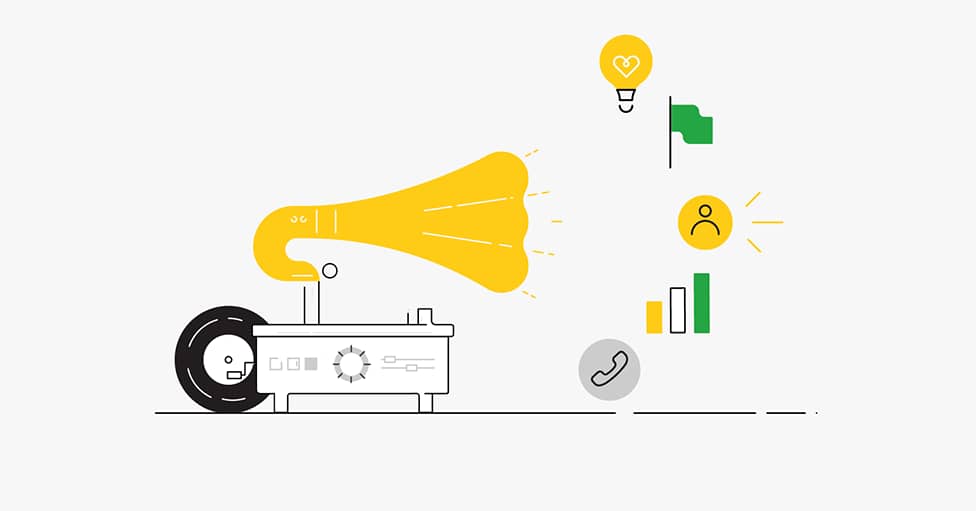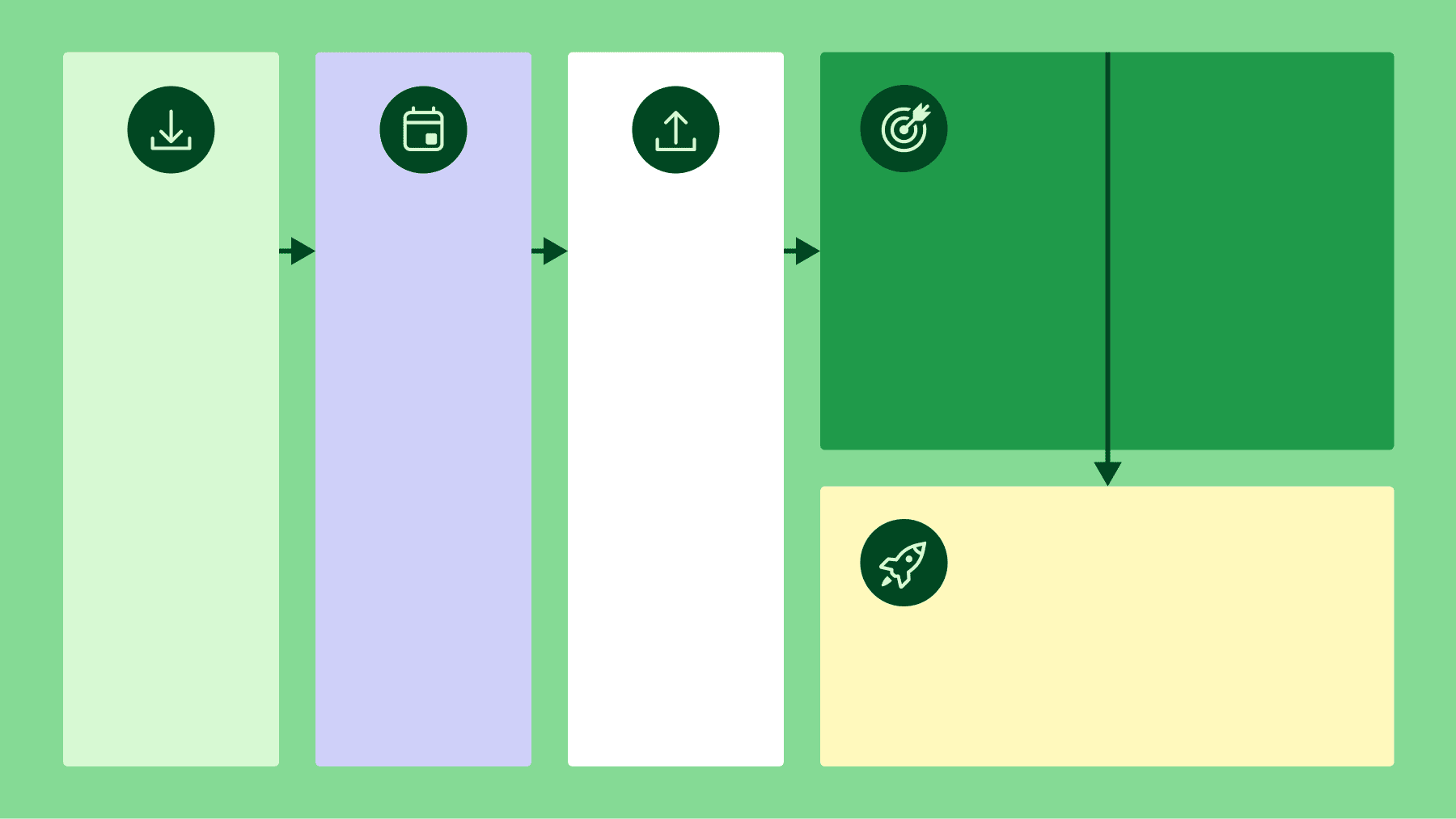You might think of a sales presentation as a simple pitch, a demo, or a list of facts and figures, but while a good presentation does incorporate all of those elements, it’s more than the sum of its parts.
Done well, and at the right time in your sales process, it gets your prospects’ attention, drums up excitement and moves them towards making a buying decision.
In this guide, we’ll cover the fundamental elements of a sales presentation, what to include, the role it plays in your sales strategy and how to deliver it. We’ll also share some of the best sales deck ever examples to use as inspiration for your own sales deck.
What is a sales presentation?
Although the terminology differs from company to company, a sales presentation is technically different from a sales pitch.
A sales pitch is usually a one-on-one interaction between your sales reps and a prospect (typically via phone call, virtual meeting, in person or even over email).
A sales presentation is a little more complicated, typically involving a meeting with several stakeholders and a demo of your product. It usually happens when your sales team is trying to close a more lucrative deal.
Sales presentations typically involve more resources, including prep time and demo testing (and sometimes travel). In many cases, more than one person from your company will give the presentation, so there’s also a need to coordinate with other team members.
Even for a seasoned salesperson who carries out daily cold calls, a sales presentation can be unnerving, as it typically involves presenting to a group of senior executives and decision-makers.
What is a sales deck?
A sales deck is the series of slides you use to guide your audience through your sales presentation.
Slide presentations can help your audience understand key statistics, pricing and product features, which your sales reps can build a story around.
The best sales decks enhance your sales team’s pitches by acting as a touchstone. They should enable your salespeople to tap into their personal knowledge and provide more information that’s personalized to the prospects and stakeholders they’re presenting to.
Even the best sales deck ever needs to be supplemented by your team’s best sales strategies to close the deal.
Storytelling and your sales presentation
Statistics, facts and figures can all help when you’re making a pitch, but they’re far more impactful if they’re relatable.
For example, if you tell a story about an existing customer who faced the same challenges as your prospect and overcame them with great success (backed by real data), they are more likely to listen.
Human beings have a deep relationship with storytelling. Stories move us, teach us and, in a sales context, persuade us. We remember stories more than we remember anything else.
Chip Heath, a Stanford professor, demonstrates the importance of storytelling in his book Made to Stick.
He retells an exercise with his students where he divided them into groups and asked them to deliver a one-minute persuasive pitch based on data he’d just shown them.
After the pitches and a short break, he asked the class to jot down everything they remembered about the pitches. 63% remembered the pitches with stories, while only 5% remembered an individual data point from a pitch with statistics.
Use stories in your sales presentation to help prospects remember the key points.
On this, sales manager at Particular Audience Thomas Dredge says:
Start with a problem
Your sales presentation should begin with the problem or pain point your customers have that your product or service solves.
According to Bradley Davies in business development at Cognism:
Keep your audience engaged by focusing exclusively on the most important features. Avoid talking about elements or problems that aren’t relevant, as they could distract your listeners from building an image of using your product themselves.
Rather than simply presenting your product, a good sales presentation draws a picture of what life could look like for a customer with a solution in place. How will their business or lives change for the better? How will their world change? Importantly, how will they reduce spending and increase revenue?
Describe your product
After you’ve illustrated your prospects’ pain points, you can start talking about your product as a solution and the specific product features that can make this exciting new world possible.
You can do this in a few ways, such as:
Positioning your features against the old way of doing things
Presenting those features as “superpowers” that will solve your prospect’s problems
Comparing those features to competitors’ features
Using a combination of some or all of the above
What to bring to your sales presentation
Pre-pandemic, most sales presentations were in-person and included visual elements, like:
A sales deck
The product itself
Handouts
Presentations from other team members
Today, many presentations are held virtually. They still require the above components, but they’re used slightly differently.
Your sales deck
Most sales presentations include a slide deck to help deliver facts, figures and statistics that support your sales narrative and help your prospects embrace your solution. You can create your sales pitch deck in PowerPoint or another slide deck application, like Keynote or Google Slides.
Great sales decks have a few key elements, such as:
A strong cover image. Your first slide needs to grab your audience’s attention.
Data. Charts, graphs and infographics are all good ways to support your story. You can get metrics from third-party sources or from your own sales dashboard.
Testimonials and case studies. Quotes and success stories from other customers will act as social proof to back up your data.
Customized content. You should personalize your presentation for each prospect. You might want to use their brand colors, find data specific to their market or industry or reference an earlier exchange.
Next steps. Your last slide should be a direct call to action, offering one or two next steps.
Keep your sales deck light on text. According to data from Venngage, 84% of presenters use visual data in their presentations as walls of text can be overwhelming.
Similarly, ensure your sales deck design uses a font (and font size) that everyone in the room can easily read. We’ll dive into some great slide deck examples in a moment.
The product
Nothing sells a product like seeing it in action.
Take the example of Scrub Daddy, a sponge that changes shape depending on the heat of the water. When Aaron Krause, Scrub Daddy’s founder and inventor, presented the product on Shark Tank in 2012, he demonstrated the sponge cleaning dirty kitchenware and greasy countertops. He also used bowls of water and two 10-pound weights to show the sponge’s amazing morphic abilities.
The tactic paid off for Krause: Scrub Daddy partnered with Lori Greiner for $200,000, in return for 20% equity in the business and is now considered one of Shark Tank’s most successful products.
So how can you show off your product?
Not all products are easy to demo, either in-person or virtually, so you may have to improvise.
With a physical product, think of the perfect environment for a demo. What would show the product at its best?
With a digital product, make sure you have the technology on hand to show what your product can do (and check beforehand that the tech works). If it’s a mobile app, have your prospects download it. If it’s a platform, it might be best to demo via a projector.
For some solutions, items that are too big to be brought in, or which are location-specific, you may have to rely on a video as part of the presentation.
Handouts
Depending on the nature of your solution, you may need to hand out materials to the prospects in the room, such as contact information or sales collateral.
Make sure this material is simple, so it’s not a distraction. You may want to distribute handouts at the end of the presentation, to ensure people are listening to you, instead of reading.
Your team
If you’re attending a sales presentation with another salesperson or as a team, it’s important to prepare together beforehand. Here are some preparation tips.
Practice, practice, practice. You’ll need to get the timing right, especially if your presentation has a lot of moving parts.
Make sure everything works. Faulty PowerPoint presentations or a broken sample can ruin a pitch presentation.
Define everyone’s roles. Who will go through each section? Will one rep introduce before another conducts the demo?
Seven sales deck examples
Below are seven sales deck examples you can use as inspiration to achieve different goals.
1. Uber

Your sales pitch deck should make a statement visually about what your product is and what it’s designed to do.
This sales deck from Uber has a strong visual style, with the theme or virality running through the text and images.
The bold colors, interesting visuals and icons make for an engaging presentation.
2. Tealet

Tealet’s presentation adopts a very different but equally effective visual style.
The visual style and palette of calming greens and creams provide an intimate link with the business concept and context for how their brand operates.
Click here for the Tealet deck
3. Snapchat

Graphs, social proof and infographics can help attendees understand critical information, but use them sparingly. Too many graphs can cause confusion.
This presentation from Snapchat shows how you can keep a stats-based deck streamlined. If your story doesn’t rely on figures, you can use your slides to feature real-world use cases for your product or help your audience keep up with the narrative using bullet points.
Click here for the Snapchat deck
4. Airbnb

This early deck from Airbnb demonstrates a sound understanding of their concept and market. You can do the same thing by including industry stats or case studies.
Click here for the Airbnb deck
5. Launchrock

Part of the role of your visual presentation is to help draw your audience’s attention to key points.
Some ways to do this are by changing the font and font size, using impact colors or using icons to draw focus to crucial information.
This deck by Launchrock uses red and blue on a black background to underscore their most important statistics, devoting entire slides to each data point. It’s simple but effective.
Click here for the Launchrock deck
6. Zuora

The best sales decks get straight to the point. It’s important that your sales deck mimics your overall sales narrative so that by the time you’re done speaking, you don’t still have several slides of information to go through.
The above Zuora sales deck continues on three slides beyond where it could reasonably end. However, by incorporating stand-alone testimonies and client success stories, they add weight to the argument that their product does what they say it does on the tin.
7. Ooomf

Your sales deck needs to resonate with decision-makers, which you can achieve easily using the following narrative structure.
The problem you see in the market that your audience will relate to
The value proposition you offer by providing a solution
How your service/product solves this problem
Here’s an example of that narrative from Ooomf:
Tailoring your sales presentation
Once you’ve created your sales deck template, it still needs to be personalized to your target audience.
You’ll know from lead generation, prospecting and sales calls that tailored pitches resonate best with prospects, and it’s exactly the same with sales presentations.
Different industries have different challenges and opportunities. If you want to sell to them, you need to address them, which means research, preparation and customization.
Danny Hayward, Sales Manager at Unruly, says:
How to nail the sales presentation
Once you’ve done your prep and it’s time for the presentation itself, here are some tips to close the deal.
Practice confident body language
Presentations usually happen in person, so you want to look relaxed and confident. To do this, you’ll need to focus on your body language.
Here are some ways you can improve your body language.
Eye contact. Making and maintaining eye contact shows people you’re invested in what they have to say, virtually or in person.
Stand (or sit) up straight. Pulling your shoulders back and fixing your posture is an easy way to convey confidence.
Chin up. Face straight ahead instead of looking at the floor, around the room or at your shoes.
Keep your audience engaged
Sales presentations are usually 30 to 60 minutes, so you need to keep your prospects interested.
Here are a few ways to keep up engagement.
1. Understand your audience’s attention span
Your audience is most likely to remember the beginning and the end of your presentation, so put your strongest material there.
2. Be funny
If you’re comfortable with it, humor can be a good way to connect with prospects, make your presentation memorable and help everyone in the room relax.
3. Use a little showmanship
Unlike a pitch, a presentation lets you pull out the stops, make a splash and showcase your solution. Use this to your advantage, and be as memorable as you possibly can. On this, Sophie Cameron, Business Development Representative at CAKE says:
Take questions
Sometimes your prospects will sit through your whole presentation and then ask questions. Other times, prospects may want a question answered right in the middle of a presentation.
If that happens, stop the presentation and take their questions head-on. You want them to know you’re listening to their concerns and taking them seriously.
You also should encourage them to share their thoughts and concerns. This is a consultative selling approach that works to build a relationship with your prospects.
What to do after the sales presentation
By the end of your sales pitch, your prospect should be ready to come along with you and start the next step of your business relationship.
Outline the next steps of the process. The first could be offering a trial of your product, scheduling a follow-up meeting or sending over a proposal.
Whatever the next steps are, make sure they’re clearly defined. If you don’t hear from them soon after the proposal, be sure to check back in. Use our free templates to send follow-up emails quickly and easily.
Final thoughts
With the right sales deck and in-person sales strategy, your presentation should be a show-stopper.
Tell a story, prove your value and show customers how they can change their business with your solution and you’ll have a killer sales presentation that sparks your customer’s interest and drives sales.








